#Apulian art
Text

Fragment from an Apulian red-figure volute-krater, depicting a woman's head (gorgoneion?) in relief. Artist unknown; ca. 350-320 BCE. Now in the Museum der Universität Tübingen, Germany. Photo credit: ArchaiOptix/Wikimedia Commons.
#classics#tagamemnon#art#art history#ancient art#Apulia#Apulian art#South Italy#South Italian art#vase painting#krater#fragment#red-figure#relief sculpture#gorgoneion#Classical Period#Museum der Universität Tübingen
261 notes
·
View notes
Text

APULIAN RED-FIGURE BELL KRATER
Ca. 400-300 BC
#APULIAN RED-FIGURE BELL KRATER#Ca. 400-300 BC#terracotta#greek terracotta#ancient artifacts#archeology#archeolgst#history#history news#ancient history#ancient culture#ancient civilizations#ancient greece#greek history#greek art
303 notes
·
View notes
Text
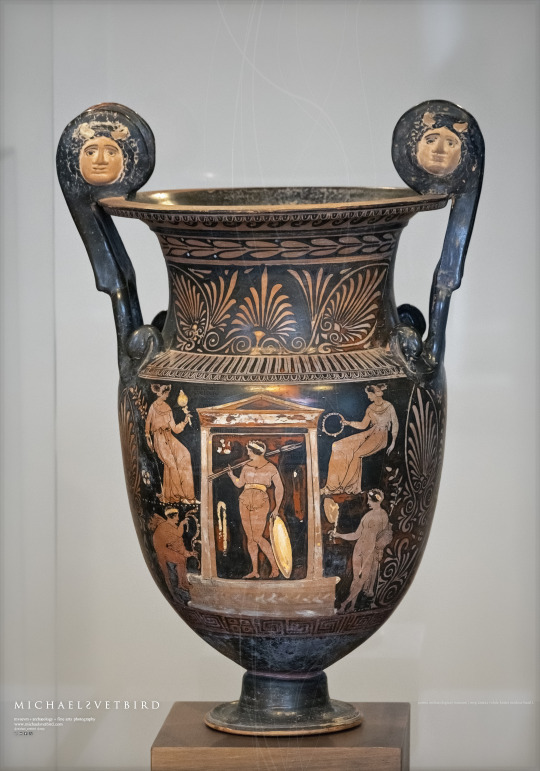


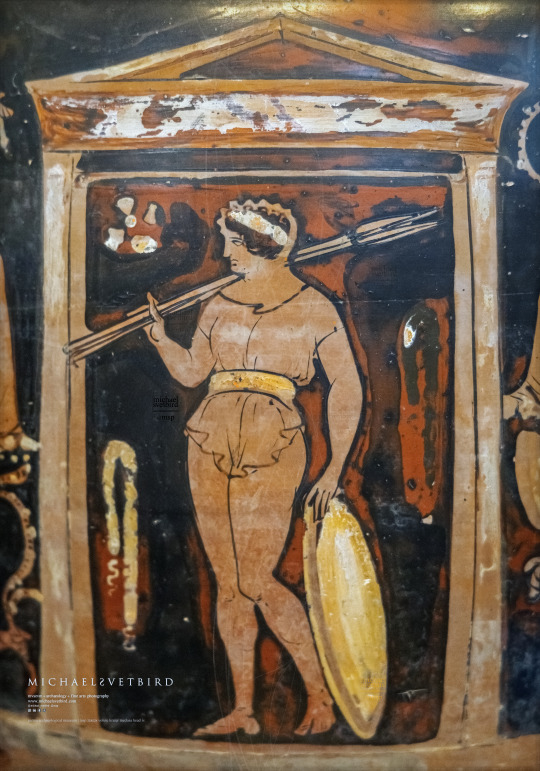
KRATER W/ THE HEAD OF MEDUSA:
Apulian Red-figured Volute Krater
Attributed to the Painter A of the Heroa Group
Ca 350 BC
[Sides A & B: Scenes from the cult of the dead]
Pic 1 : Side B;
Pic 2 : Side A, upper register, Medusa's head close-up;
Pic 3 : Side A;
Pic 4 : Side B, vessel body close-up:
Male or Female [4] ?..
Somebody's portrait? What is your opinion?
Museo Archeologico Nazionale di Parma | MANP
[Pilotta, Archaeological Museum, Floor 2]
https://complessopilotta.it/en/archaeological-museum
MANP | Michael Svetbird phs©msp 22|02|24 6000X4200 600 [I., III., IV.]
The photographed object is collection item of MANP, photos are copyrighted
[non commercial use | sorry for the watermarks]
.
#parma#archaeological museum#museo archeologico#apulian#puglia#magna grecia#krater#red figure pottery#vase painting#ancient pottery#pottery#ancient art#antiquity#ancient#archaeology#museology#museum#mythology#greek mythology#art history#antiquities#heritage#cultures#medusa#μέδουσα#warriors#art photography#archaeology photography#museum photography#michaelsvetbird
26 notes
·
View notes
Text


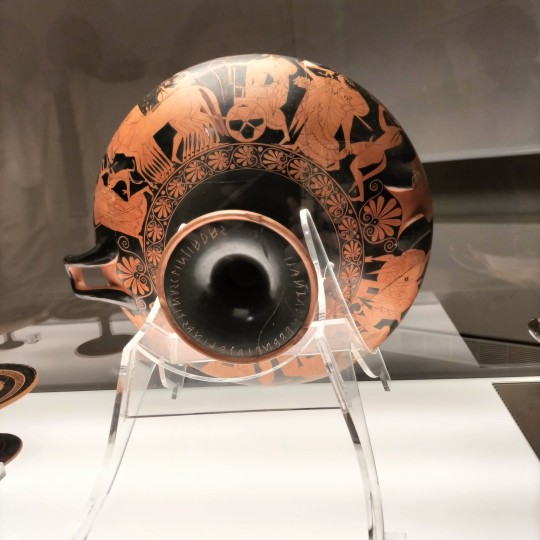
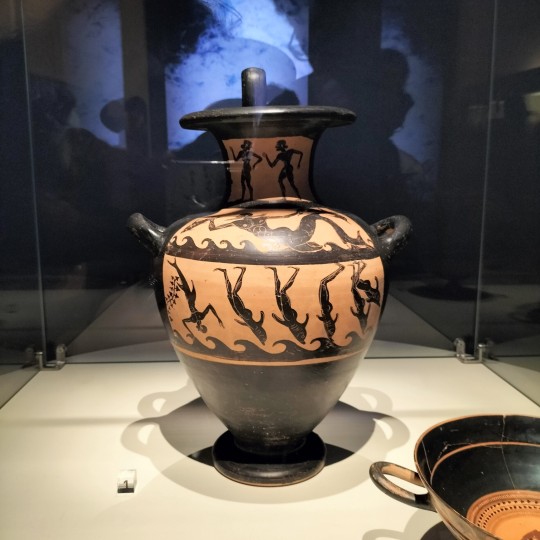

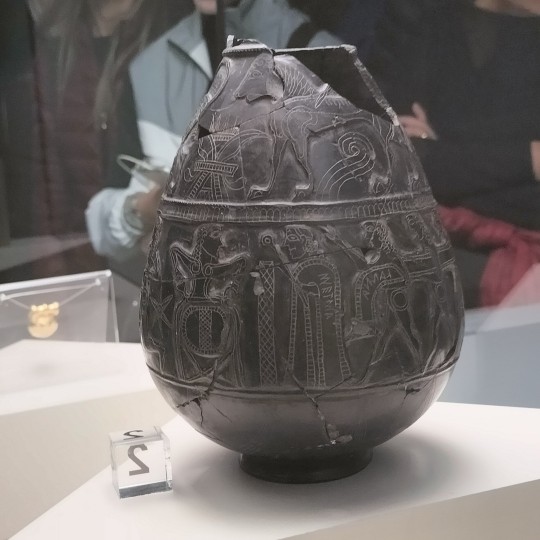

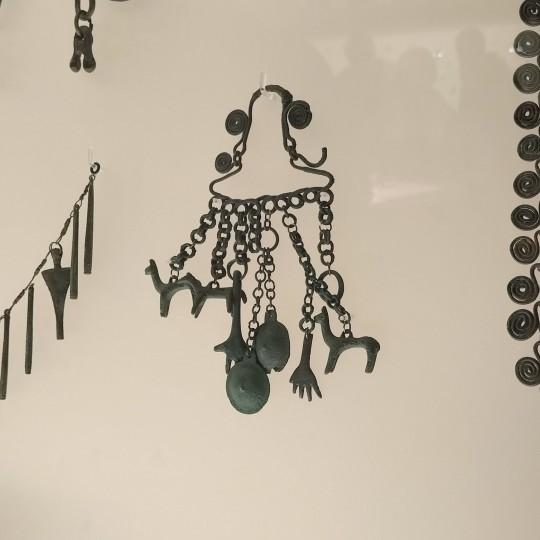
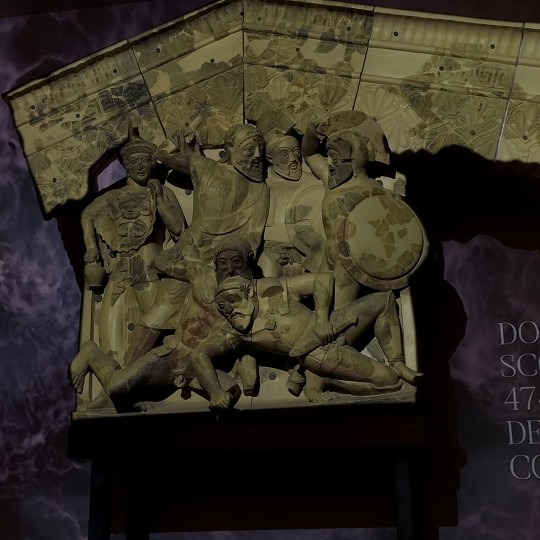

some pictures i took at the national etruscan museum of villa giulia in rome on nov 21st
#it's just me and IV century BCE fish plates against the world#i am in love with this museum. lighting fucking sucks tho#paiawon.txt#archaeoblr#archaeology#art history#etruscan#etruscan archaeology#tagamemnon#national etruscan museum#la chimera#greek pottery#etruscan pottery#apulian pottery#my photos#my pics
39 notes
·
View notes
Text

Frog-Shaped Guttus (Oil Flask)
300s BC
South Italian, Apulian
Ceramic
Cleveland Museum of Art
586 notes
·
View notes
Text
#FrogFriday:
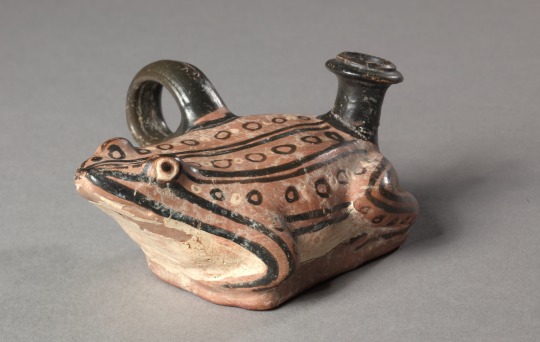


Ceramic Frog-Shaped Guttus (Oil Flask)
South Italian, Apulian, 4th c. BCE
Diameter: 1.5 cm (9/16 in.); Overall: 5.8 x 11.2 x 9.1 cm (2 5/16 x 4 7/16 x 3 9/16 in.)
The Cleveland Museum of Art 1985.176
"Guttus is a Latin word referring to a small vessel with vertical spout and ring handle, probably used for pouring small amounts of precious liquids. Often, mold-made ceramic gutti take the form of animals, with realistic painted decoration."
#Cleveland Museum of Art#frog#guttus#flask#Italian art#ancient art#ceramics#effigy vessel#animals in art#Frog Friday
82 notes
·
View notes
Text
Cassandra and the omphalos
Regarding Cassandra and the omphalos. In Aeschylus' Agamemnon, when Clytemnestra asks Cassandra to get inside, she says [1055] I have no time to waste with this woman here outside; for already the victims stand by the central hearth awaiting the sacrifice—a joy we never expected to be ours.
The word used for central hearth is μεσόμφαλος, which is also related to Delphi: μεσόμφα^λ-ος , ον, A.in mid-navel, central, used esp. of Apollo's shrine at Delphi,
So it's discussed that maybe Clytemnestra is mocking Cassandra by using language related to Apollo's service.
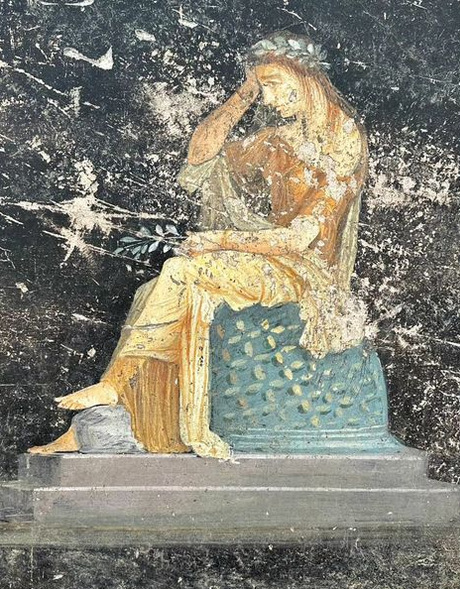
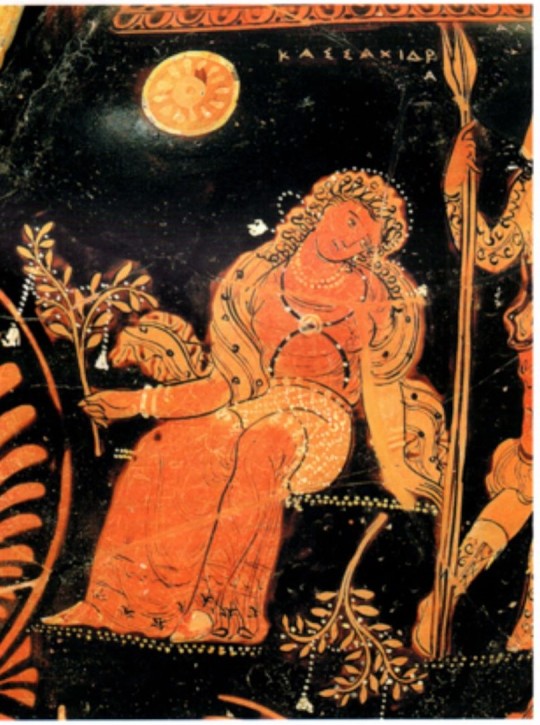
The omphalos is depicted with a net on top of it, not sure if it's exactly an agrenon (a woolen net-skirt worn by priestesses) or if the agrenon symbolizes the omphalos' woolen net. Above is a vase where Cassandra is wearing an agrenon, and in Aeschylus' and Euripides' plays we are told that Cassandra wears priestly attire, with laurel leaves that connect her to the Pythia of Delphi, as prophetic priestess.
We could also make some kind of connection between the "net" used to caught Agamemnon and the agrenon worn by Cassandra and the omphalos' net.
There are also depictions of Orestes holding the omphalos or taking refuge by it, but in this context, Orestes is meant to be physically in Delphi, inside the temple. I'm curious: why the Romans would depict Cassandra sitting on an omphalos. Were there omphaloi outside Delphi?
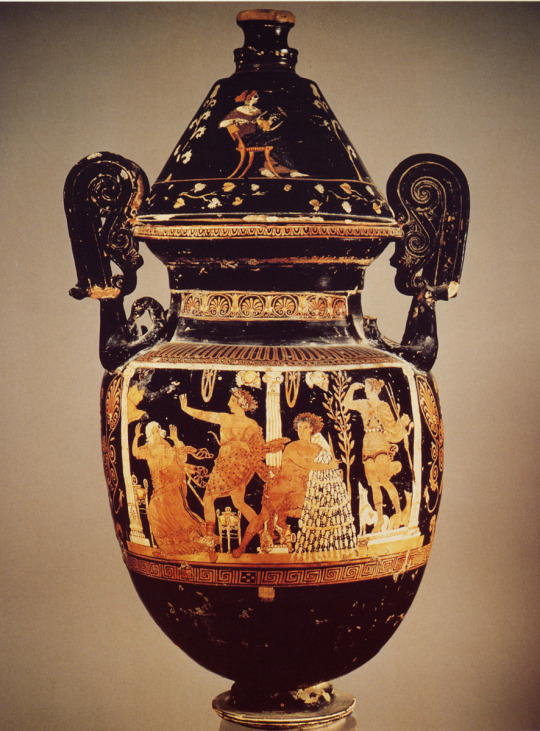

sources: Torn Fillets and a Broken Sceptre: Cassandra’s Costume, Props and Attributes in Ancient Greek Drama and Vase-Painting by Fabio Lo Piparo
Aeschylus' Agamemnon
Mixing bowl (bell-krater) depicting Orestes at the Delphic Omphalos MFA Boston
South Italian - Apulian Black Fury painter's Orestes crater - Classical Art Research Centre Univeristy of Oxford
ATENAS Y DELFOS: ADIVINACIÓN, LEY Y LENGUAJE EN LA ORESTÍADA* ANGUS BOWIE
18 notes
·
View notes
Text
Body Fat in Greco-Roman Antiquity (transcribed article)
A long time ago I made a post about the depictions of Dionysos/Dionysus/Bacchus as fat. You can read it here if you want - but that was just me going on about stuff taken left and right, nothing too serious, just thoughts.
I want to bring you today a serious article about the perception of the fat body in Ancient Greece and Ancient Rome. This article is actually a page hosted on "Google Arts and Culture", titled "In the Flesh: Body Fat in Ancient Art". It was created by the J. Paul Getty Museum, and you can read it all here. But the website has a really specific design that makes it hard for some people to read the page, so I thought why not help share it around by copying it below. Of course, nothing belongs to me, I am just transcribing it all (plus copying the images). All credits go to the J. Paul Getty Museum.
In the Flesh: Body Fat in Ancient Art
Ancient Greek and Roman writers criticized bodies of different sizes for a variety of reasons. But in works of art, body fat was often depicted in ways that defy our expectations.
A Different Ideal
Terms like "overweight" and "underweight" originate in modern medicine's concept of an ideal body weight. Calculated to minimize mortality risk, this medically desirable weight varies based on such factors as height, age, and fitness.
Ancient Greeks and Romans compared the appearance of their bodies with respect to a more abstract ideal.
For the ancient physician Galen, measurements for the ideal body were expressed centuries earlier in the Canon, a treatise on statue proportions by the 5th-century BC sculptor Polykleitos:
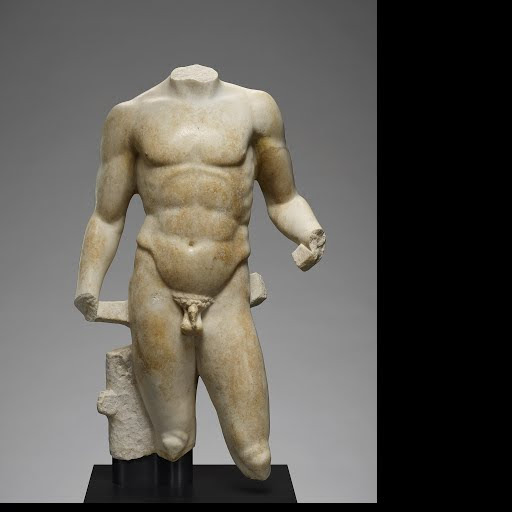
(Male torso, about A.D. 100, Unknown)
"[Neither the overweight nor the underweight body] is in due proportion. But the body which equals the Canon of Polykleitos reaches the summit of complete symmetry."
— Galen, Ars Medica K 343
For the ancient Greeks, precisely measured weight was less important than the perception of symmetry and balance.
They had a term for this desirable state of wellness: εὔσαρκος (eusarkos), meaning "well-fleshed" or "fleshy."
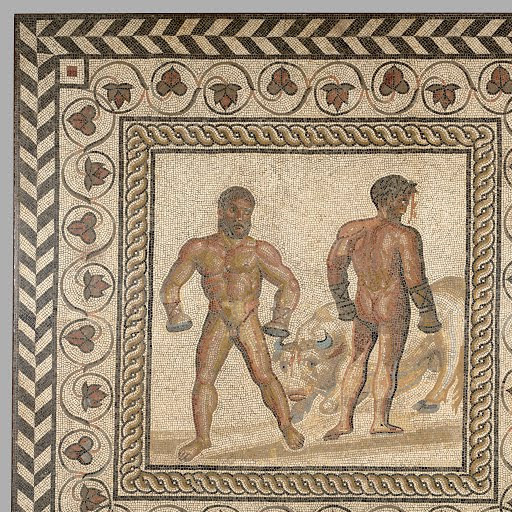
(Mosaic floor with combat between Dares and Entellus, A.D. 175-200, Unknown)
Because the Greeks prized moderation in all things, bodies or behaviors that stood out from this ideal were targets of criticism. Perhaps surprisingly, this criticism also applied to muscular athletes, such as wrestlers and boxers, who required constant high-calorie diets.
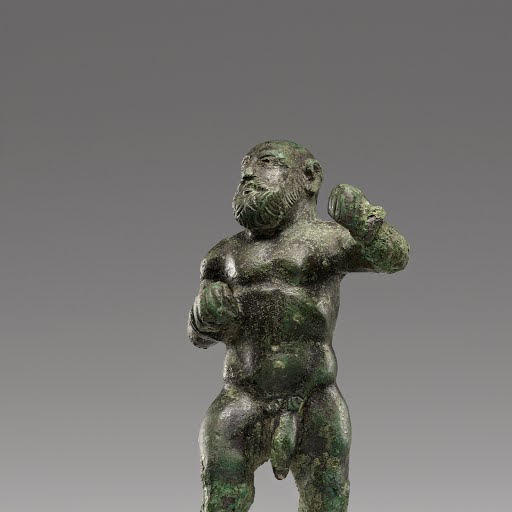
(Statuette of a boxer, unknown)
Big Bodies in Comedy
Mockery of those who ate more or less than necessary was one way to impose social compliance and maintain political order.

(Apulian red-figure bell krater, 370-360 BCE, Cotugno painter)
Many Greek and South Italian vases often depict comic actors wearing "fat suits" (as well as a mask and a phallus) to embody popular character types.
Actors used such props as comic gags, and vase painters often represented them with great care.

On this Apulian mixing bowl, lines extending across the actor's chest make clear that his large, sagging breasts are artificial. His belly is unnaturally circular and hangs too low — further evidence that he is wearing a costume.
It seems that the painter wanted to pointedly emphasize the exaggerated nature of such costumes.
Ample Satyrs
Not all depictions of larger bodies were mocking. Animal ears and the double flute identify this figure as a satyr, or a woodland deity. He reclines in a pose that would remind viewers of the satyrs' master, the wine god Dionsyos, who is often depicted reclining at a banquet.
Instead of on a fancy couch, the chubby old satyr rests on a full wineskin!

(Fragment of an Apulian squat Lekythos, 350-325 BC, Darius painter)
Under tufts of gray hair, lines accentuate the curving folds of the old satyr's body. Unlike the ridiculously artificial bodies of the padded actors, the satyr's big, hairy body is gentle and soft.
Like the plump pillow on which he rests, the satyr appears comfortable and at ease. This scene is meant to be lighthearted, and does not appear cruel or mocking.
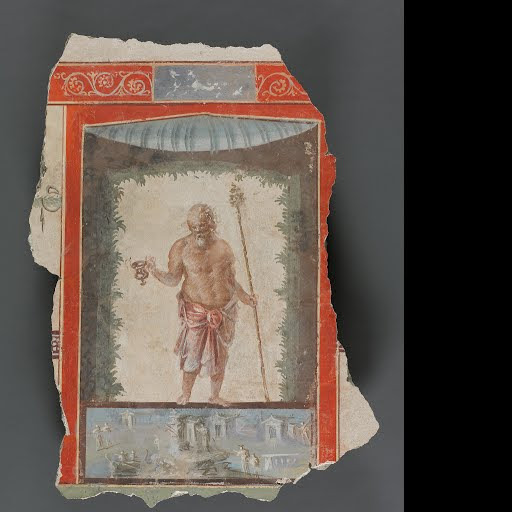
(Fresco fragment depicting an old Silenos with kantharos and thyrsos, AD 1-79, Unknown)
Similar attention to detail can be seen in this Roman wall painting of the old satyr Silenus. The painter’s skillful use of red shadows and pink highlights builds up the volume of his chest and stomach, which appear both soft and sturdy at the same time.
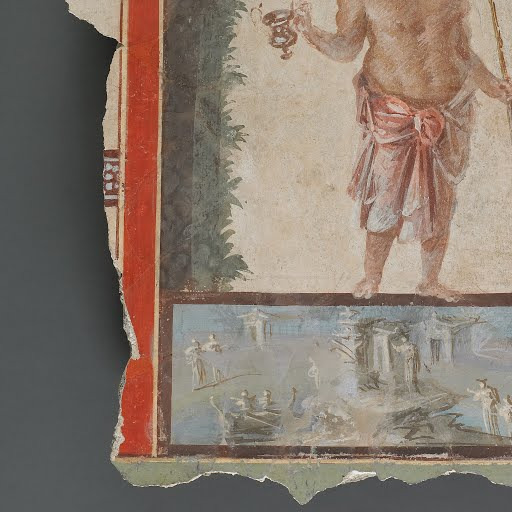
These fleshly older satyrs were symbols of pleasure-seeking and leisure.
Fragile Bodies on the Margins
Skinny or underweight bodies were also criticized, in part because of the association between emaciation and illness. Thinness could also negatively reflect on one's character.

(Miniature skeleton, unknown)
Ancient authors often noted a person's skinny frame as a way of pointing out their intellectual or social irrelevance.
The association of thinness and powerlessness is sometimes exploited in representations of enslaved individuals, domestic servants, and those otherwise marginalized in society.

(Finial with a resting youth, unknown)
On this figurine of a resting youth, the individually shaped ribs might suggest that the figure is undernourished.

In depictions of older individuals, such as this statuette of an old woman, underweight features are often used to indicate frailty.

(Statuette of an old woman, 100-001 BCE)
Such subjects were popular in the Hellenistic period (c. 330-31 BC) —a time of unprecedented social inequality — and consciously aestheticized:
"When we see emaciated people we are distressed, but we look upon statues and paintings of them with pleasure, because imitation, as such, is attractive to the mind's nature."
- Plutarch, Quaestiones convivales 5.1.
Size and Gender
Body fat was also linked to gender, especially in the Roman Empire. While bodies of women were routinely criticized by Roman authors, fluctuation in weight did not render them less feminine. By contrast, both fat and skinny men were explicitly mocked as effeminate, lacking either physical strength or stamina.
Biographies of unpopular Roman emperors often weaponize their body size in this way. Of the emperor Galba, the biographer Suetonius writes, "it is said that he was a heavy eater," immediately before turning to rumors about his inclinations towards "unnatural desires."
Such fat-shaming seems not to have mattered to the emperors themselves. Their official portraits show little concern for concealing the fullness of their faces.
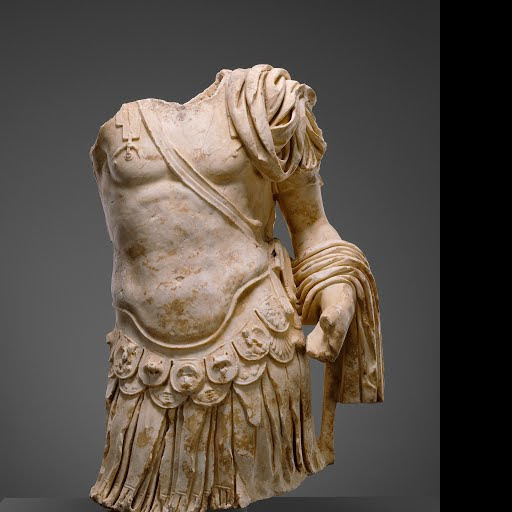
(Torso of a cuirassed statue, unknown)
The situation may have been different in military affairs. The anxieties Roman men felt about their bodies can be seen in their choice of armor. Their bronze breastplates were decorated with chiseled pectorals and washboard abs, creating the illusion of a skin-tight fit.
It is unlikely that such breastplates were meant to deceive, any more than the fat suits of comic actors. What they offered to their wearers was the illusion of inhabiting — for a moment — the ideal body of a Polykleitan statue.
Divine Softness
A closer look at ancient art reveals that the bodies of gods were sometimes less harshly judged than those of mortals.
Depictions of certain gods regularly focus on the softer parts of their bodies.
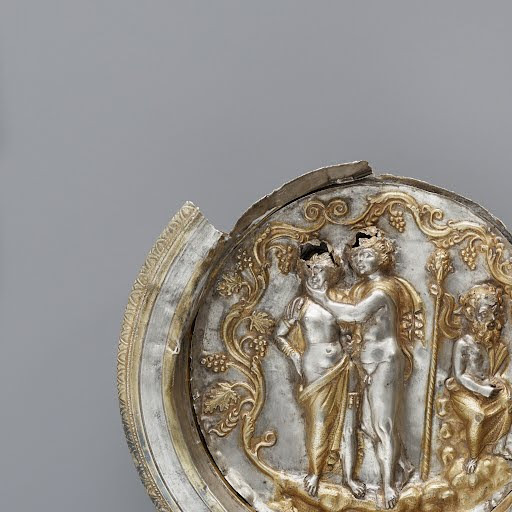
(Bowl with a medallion depicting Dionysos and Ariadne, unknown artist, -100)
The maker of this Hellenistic silver medallion went out of their way to show the curvy bodies of the wine god Dionysus and his wife Ariadne, engraving lines under their bellies to highlight the sensuality of their encounter.
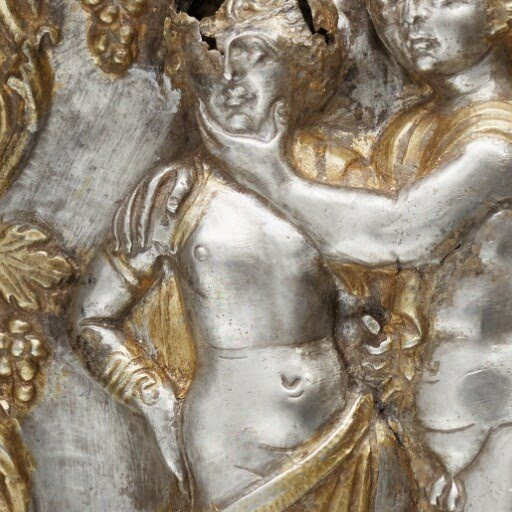
Some popular representations of the love goddess Venus, such as the so-called "Crouching Venus" type, unquestionably emphasize the fleshiness of her body.

Statue of a Crouching Venus Statue of a Crouching Venus, Unknown, A.D. 100–150, Provenant de la collection : The J. Paul Getty Museum
Modern observers have highlighted the positive associations between fleshiness and fertility expressed by a variety of Greek and Roman authors, but there is more to the story.
The rolls of flesh on the goddess's belly also gave the ancient sculptor a means of creating a very intimate encounter between viewer and goddess.
To ancient viewers of all ages and genders, accustomed to seeing gods represented solemn and upright, the crouching pose allowed a glimpse into the goddess's private world.
The crouching goddess seemed more approachable to worshippers, in part because her body moved in ways they could recognize from their own lived experience. The softness of Venus’s body made the cold, hard marble come to life.
#ancient greece#ancient rome#body positivity#fatphobia#greek gods#body fat#venus#dionysus#dionysos#ariadne#roman emperors#satyrs#underweight#satyr#silenus#ancient art#ancient greek art#body types#art#weight#ancient greek society#roman empire
21 notes
·
View notes
Text
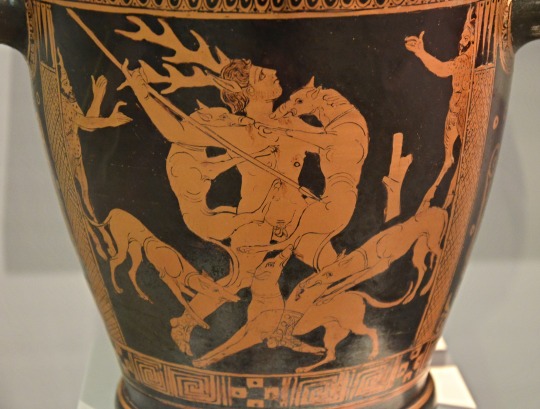
Actaeon, in the process of transforming into a deer, is set upon by his hounds. Apulian red-figure skyphos, artist unknown; ca. 400-350 BCE. Now in the Badisches Landesmuseum Karlsruhe, Germany. Photo credit: Carole Raddato.
#classics#tagamemnon#Ancient Greece#Classical Greece#Magna Graecia#classical mythology#Greek mythology#Actaeon#art#art history#ancient art#Greek art#Ancient Greek art#Classical Greek art#South Italian art#Apulia#Apulian art#vase painting#red-figure#skyphos#Badisches Landesmuseum Karlsruhe
820 notes
·
View notes
Text

APULIAN RED-FIGURE DECORATED AMPHORA
Ca. 4th century BC.
Magna Graecia
L:305mm / W:140mm ; 805g.
#APULIAN RED-FIGURE DECORATED AMPHORA#Ca. 4th century BC#Magna Graecia#pottery#ancient pottery#ancient artifacts#archeology#archeolgst#history#history news#ancient history#ancient culture#ancient civilizations#roman history#roman empire#roman art
254 notes
·
View notes
Text
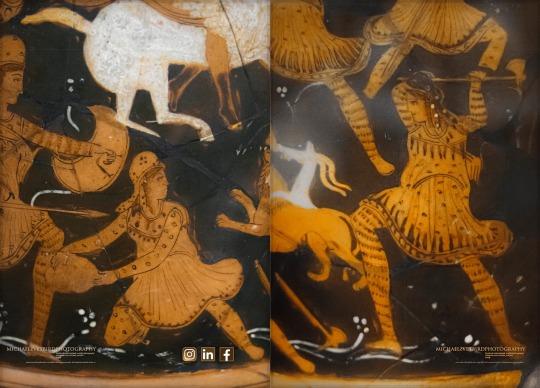
• AMAZONS vs Bellerophon on Pegasus & Chimera:
Side A of Apulian Red-figure Krater depicting
Amazonomachy, Mythical Creatures
[Late] 6 BC.
From Falerii [Southern Etruria, near Rome]
Museo Nazionale Etrusco di Villa Giulia, Rome
Direct Links to the Full Photo-set:
Instagram:
https://www.instagram.com/p/Cj7eHnSox6T/?utm_source=ig_web_copy_link
LinkedIn:
https://www.linkedin.com/feed/update/urn:li:activity:6988787209176776704
Facebook:
https://www.facebook.com/michael.svetbird/posts/pfbid0f1Ysf4GRF4QeZsvU6qPtnmvrBPfUv3hL5a9VqHojajv8gx25V2DMA7tvxHhAe4jal
#rome#villagiulia#museoetruscovillagiulia#etru#archaeologicalmuseum#historymuseum#ancientart#vasepainting#pottery#ancientceramics#redfigure#krater#apulia#magnagrecia#arts#arthistory#etruria#ancientcultures#apulian#antiquity#archaeology#archaeologyart#museology#mythology#greekmythology#amazons#amazzoni#amazones#warrioress#bellerophon
3 notes
·
View notes
Note
hey! i've been reading about the judges of the dead and i've seen triptolemos be mentioned as the judge presiding over the initiates of the mysteries but i'm having trouble finding sources. do you know if he was officially considered a judge or not? thanks!
Hi! As far as I know, the only mention of Triptolemus being a judge comes from Plato, in Apology 41a:
|41a If, when someone arrives in the world of Hādēs, he is freed from those who call themselves jurors [dikastai] here, and finds the true [alētheîs] judges [dikastai] who are said to give judgment [dikazein] over there [ekeî]—Minos and Rhadamanthus and Aiakos and Triptolemos, and other demigods [hēmi-theoi] who were righteous [dikaioi] in their own life—that would not be a bad journey [apo-dēmiā], now would it? To make contact with Orpheus and Musaeus and Hesiod and Homer—who of you would not welcome such a great opportunity? Why, if these things are true [alēthē], let me die again and again.
Dr. Patrick Hunt has an article published here on the passage that might be relevant to your research as well.
More generally on the topic, Jan N. Bremmer says this in Initiation into the Mysteries of the Ancient World (go grab it, it's in open access):
The connection of Eleusis with agriculture is also manifest in the equally prominent position in Eleusis of Triptolemos, the inventor of agriculture, who only in the fourth century becomes a judge in the underworld, and by the presence on a fourth-century Apulian vase of personified Eleusis sitting next to Eniautos, ‘(The products of the) Year’, holding a horn of plenty that sprouts ears of wheat.
Which is an interesting comment because it also lines up with a change in his cult in Athens at the same period, as indicated by Isabelle K. Raubitschek and Antony E. Raubitschek in The Mission of Triptolemos:
The transformation of Triptolemos from an instructor of the Athenian farmers in the art of agriculture into a hero, charged by Demeter to spread the knowledge of farming throughout the world, took place, according to the vases illustrating this mission, between 510 and 480 B.C., when renewed activity is attested both in Eleusis and in the Eleusinion in Athens. This propaganda effort with its emphasis on the Mission of Triptolemos beyond the borders of Attica may be connected with the claims of the newly founded Athenian democracy to be the mother city of all the Ionians.
Which leads to comment on the difficulty of officiality in ancient Greek religion. There is no direct mention of Triptolemus as a judge outside of Plato in the sources we know of that I could find, but his story otherwise predates the 5th century by far. Everything here seems to indicate a shift in worship that attributed this new role to him in Athenian context. And from that point on, it's possible that the idea of him as a judge spread across Greece through the cultural impact of Athens.
To add to uncertainty, we do not know enough of the specifics of his cult within the Eleusinian Mysteries to know if there was an evolution in his role during the mysteries themselves.
Before I wrap this up, just a headsup that the most important study (to date) on Triptolemus was written by Gerda Schwarz in 1987. It was never translated from German and I couldn't find a copy online but I noticed that the German Wikipedia page is more detailed as a result of that work being in the bibliography.
13 notes
·
View notes
Text
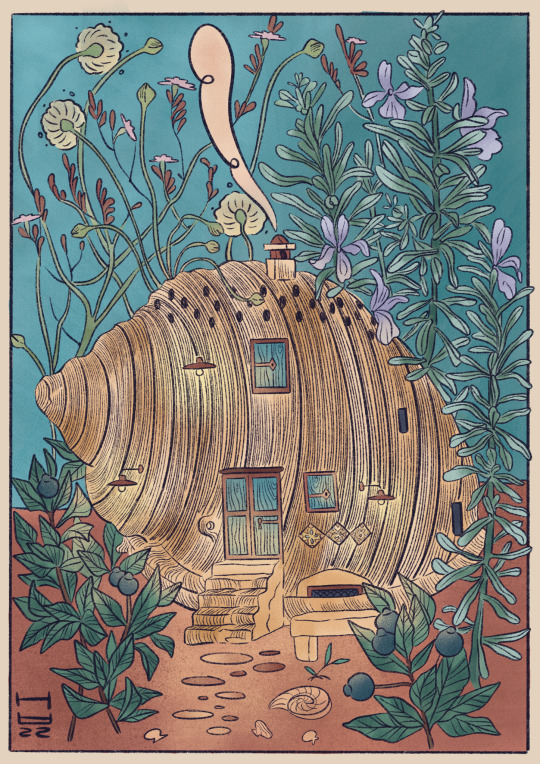
Tiny home n.4 🐚🌾✨
Dedicated to my beautiful, red-soiled apulian landscape with myrtle, wild rosemary and limonium bushes all dotting up the seaside.
If you like my art, please consider supporting me on Patreon, commissioning me or buying me a coffee. If you can’t do any of those things it’s chill, but a reblog helps so much by itself too! Thank you 🖤
#digital art#illustration#financial help#financial support#Patreon#Patreon artist#ko fi#kofi#ko fi donations#commissions open#commission#artist on tumblr#illustrators on tumblr#artist#illustrator#plants#cottagecore#cute#art#original art#queer artist#trans artist#gay artist#lgbt#queer#transgender
34 notes
·
View notes
Photo
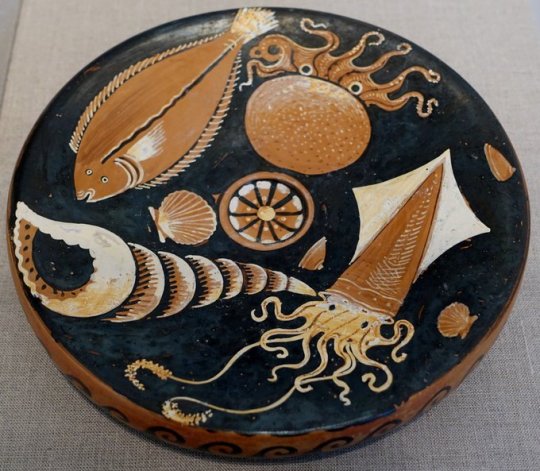
Apulian red-figure terracotta fish plate. Attributed to the workshop of the Darius Painter; ca. 340-320 BC. Now in the Blanton Museum of Art, Austin, Texas.
7 notes
·
View notes
Note
sage!
sage ⇢ what ‘medium’ of art (poetry, music, fiction, paintings, statues etc.) is the most touching to you? why do you think that is?
I am going to use this ask to talk about Ancient Greek pottery more! Specifically 2 red figure kraters.
In red figure, the potter would throw the clay into the vase shape, cure it, and then glaze it / paint it with black and sometimes white to create the image. The red you see is actually that of the clay so everything was done in inverse which is just so cool to me.
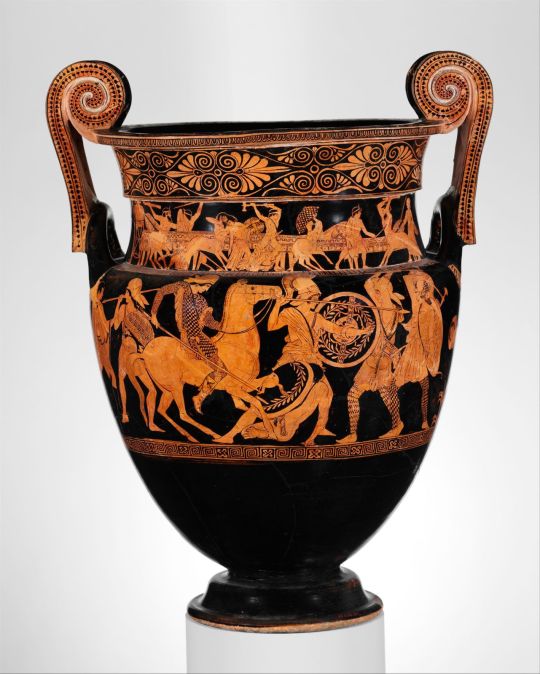
^^This is a krater from the archaic period in Athens and I mean LOOK at it! It’s so detailed and just jaw droppingly gorgeous. This krater would have been used to dilute wine and depicts a battle between the Greeks and the Amazonian warriors (perhaps the scene written by Herodotus!) Amazomachy (the word for these Greco-Amazon battles) was a pretty damn popular scene type to depict in the 5th century BCE in Athens but is most frequently found as mural or large scale paintings in homes or public buildings.

^^This Apulian (not in Greece!) krater is dated to 116 AD and is even MORE detailed. It depicts two women approaching a funeral monument holding offerings or votives. You can really see the passage of time here from the archaic Attic piece to this piece of the same shape from the Italian peninsula 500 years later, but the influence and technique of its predecessors is still being applied! Can you tell I love kraters?
I think what strikes me most about ancient pottery isn’t just the beauty of it. It’s also the acknowledgment of people before us and their skill and their diversity. Historians and academics can often try and summarize or lump together art and peoples if they’re just similar enough without properly acknowledging the personhood of those who created and used these items and how they interacted with each other through time.
For me ancient pottery is just such a big reminder about humanity, craft, and the ever changing nature of personal and cultural values - it won’t be like this forever and it hasn’t been like this for long!
Thank you for the ask I hope this wasn’t too nerdy lol!! 🏺❤️✨
5 notes
·
View notes